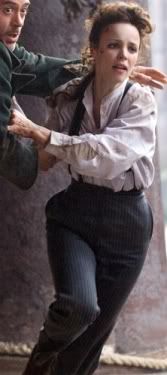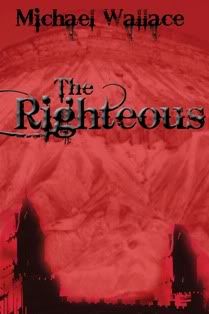 |
| Irene Adler in the 2010 Sherlock Holmes movie |
 |
| The cast of the Sister Wives reality show |
What's my point?
When writing, it can be tempting to make our characters think and act like we do. For example, I hate to wear skirts, I don't want to share my husband, I find foot binding gross, I think slavery is bad and I would never marry anyone I didn't love. But if I'm writing about a character who lives in a different time, place or culture than my own then it's very likely that her beliefs won't be exactly like mine. She might think bound feet are beautiful. She might never have a second thought about having an arranged marriage or being her husband's third wife. If I force my beliefs on her, it will make her seem unauthentic.
The idea for this post came when reading the second book I bought for my Kindle, The Righteous by Michael Wallace. It's a murder mystery set in a modern polygamist settlement. What I found most interesting about it was that the two main characters, a brother and sister, are polygamists and they are just fine with it, thank you very much. The sister, who is looking for a husband, doesn't have a problem sharing a husband as long as he's someone she can love. The brother is a little more liberal-minded and questions some things about his church but still has faith in it. I admire that the author let the characters be themselves and treated their beliefs with respect.
It's not just beliefs that we need to respect, it's the social norms of the setting as well. I can't tell you how many historical fiction books I've read where the spunky heroine trots about town in men's clothing. No stuffy dresses for her! She has to be free! Oh, a few people are scandalized by it but that doesn't matter because the hero secretly admires her independence. From a modern point of view, we find it perfectly appropriate for her to wear pants. But in the Regency and Victorian eras, a woman wearing trousers would be like you or I going out in public in our underwear. Sure, Lady Gaga does it but would you? Probably not unless you had a really good reason. Likewise, our characters shouldn't dismiss their own social norms without a strong motive.
 |
| Irene Adler's boots. If you want us to believe that your character is wearing men's clothes for comfort and maneuverability, these aren't the kind of shoes she should wear. |
In the Sherlock Holmes movie, Irene runs around in trousers for no apparent reason. With high-heeled boots and barely contained hair, she's obviously not trying to pass as a man (as the Irene from Scandal in Bohemia does) so the only reason I can think of is that the filmmakers wanted her to seem scandalous.
Here's a good quote about the trousers thing from All About Romance Novels: Author Jo Beverley says, "My problem with many cross-dressing books is why it's such a great thing to dress in male clothes in a time when it's scandalous. If forced to it to survive, that's one thing, but I really have to be convinced if a young woman chooses it when she'll be seen as a freak."
Of course there are always exceptions. If a character has a good enough reason then they may behave outside social norms. For a real-life example, read about Dr. James Barry, a military surgeon in the 1800s who was believed to actually be a woman named Margaret Ann Bulkley. She wanted to practice medicine so badly that she lived as a man for 46 years:
 |
| Dr. Barry |
Further reading:
- "Wallpaper Romances." A term that describes historical romance novels where the only thing historical is the setting (the "wallpaper"). The characters think, act and sometimes even talk like modern characters. Also see here and here.
- There are several TV tropes relevant to this subject: Values Dissonance, Eternal Sexual Freedom, Culture Blind and Politically Correct History.

No comments:
Post a Comment